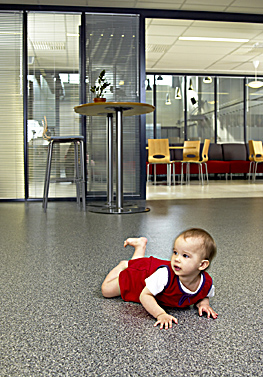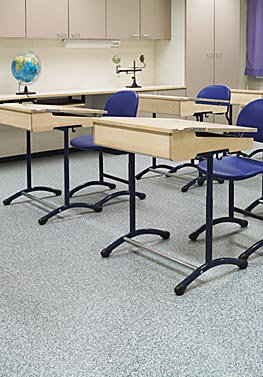Resilient contract sheet flooring. PVC- and plasticizer-free
LifeLine Forte homogenous tile flooring complements the PVC and plasticiser-free LifeLine product family with a contrasting pattern in seven attractive colours.
Special attention was paid to the increased awareness floor coverings to ensuring clean indoor air quality, demand for construction materials to support sustainable development. LifeLine represents a globally unique product that has expanded to an entirely halogen-free product family. Markets for this product family have expanded to Central Europe the USA and New Zealand.
Required fields are followed by *.
Item of interest: (5600), LifeLine
 LifeLine Forte sheet flooring complements the PVC and plasticiser-free LifeLine product family with a contrasting pattern in seven attractive colours. A strong pattern and easy-to-maintain ionomer surface guarantee a long service life with low maintenance costs. LifeLine Forte is an ideal solution for public spaces subject to extremely heavy wear, such as school corridors and classrooms, and department stores.
LifeLine Forte sheet flooring complements the PVC and plasticiser-free LifeLine product family with a contrasting pattern in seven attractive colours. A strong pattern and easy-to-maintain ionomer surface guarantee a long service life with low maintenance costs. LifeLine Forte is an ideal solution for public spaces subject to extremely heavy wear, such as school corridors and classrooms, and department stores.
LifeLine Forte was developed to meet the requirements of cost-efficient cleaning in heavy-wear spaces. In classrooms, for example, the maintenance of light and almost single-coloured flooring can be three times more costly than the maintenance of flooring with contrasting colours.
Forte is of the same thickness as other LifeLine floorings and can be used in combination with other LifeLine products. The seven colours of the Forte products are also available in 50x50 cm LifeLine tiles.
x) Emissions test no: VTT-S-04272-07 8.5.2007
LifeLineTM- an innovative heavy duty flooring material - a safe choice for people and the environment
LifeLineTM floor coverings are manufactured in Finland using an innovative new material developed by Upofloor. LifeLine flooring material is completely free of PVC and plasticizers. It provides excellent performance characteristics without compromising human safety or care for the environment. The elastic LifeLine material is made from natural Finnish minerals and pure thermoplastic polymers. It is free of PVC, plasticizers, phthalates, halogens, chlorine, and heavy metals.
A golf-ball-like surface for unbeatable performance
The ionomer-impregnated wear layer of LifeLine floorings is made from the same material as golf balls, which gives the material excellent resistance to shocks, indentations and wear. LifeLine floorings are classified in the best wear-resistance class (Group T).
The ionomer wear layer does not require waxing. The compact surface rejects dirt, which makes it easy and effortless to clean and minimizes maintenance costs. The texture of the surface also provides light friction, making it pleasant and safe underfoot.
Safe and hygienic
LifeLine floorings are ideal especially in hospital conditions, as they are easy to clean, hygienic and resist chemicals. In addition, the flooring does not act as a substrate for bacteria (such as MRSA). The material is also safe in terms of indoor air. An emissions test carried out by the Technical Research Centre of Finland (VTT) found zero volatile organic compounds (VOCs). LifeLine floorings are also fire resistant and do not generate such toxic combustion gases as PVC and rubber floor coverings do.
The material is fully recyclable during production and when disposed of, it can be utilised as normal energy-producing waste.
LifeLine product family
The LifeLine product family comprises LifeLine tiles, LifeLine CS and Forte sheet floorings as well LifeLine LT design tiles. All LifeLine products are the same thickness, 2 mm, which makes it possible to create unique and inspiring floors by combining different tiles and sheets in the same space.
The product family also includes LifeLine skirting and welding rods.
 EN 685 21-43
EN 685 21-43
Heavy wear public spaces, e.g. hospitals, schools, shops, offices, day care centres, retirement homes
| Product | LifeLine Forte, PVC- and plasticizer free contract sheet flooring | ||||
| Application |
|
||||
| Thickness | EN 428 | 2,0 mm | |||
| Weight | EN 430 | 3,200 g/m2 | |||
| Roll length | EN 426 | 10 – 25 m | |||
| Width | EN 426 | 145 cm | |||
Product properties |
|||||
| Property | Test method | Result | |||
| Fire resistance | DIN 4102 |
Cfl - s1 |
|||
| Emissions |
|
||||
| Residual indentation | EN 433 (2,5 h) | < 0,05 mm | |||
| Impact sound insulation | ISO 140-6 / ISO 717-4 | ∆Lw n. 3 dB | |||
| Dimensional stability | EN 434 (6h 50C) |
< 0,2 % |
|||
| Effect of castor chair | EN 425 | No effect | |||
| Abrasion resistance | EN 660-2 | Group T (< 2,0 mm3) | |||
| Tensile strength of welding seam | EN 684 | > 400 N/50 mm | |||
| Colour fastness | EN ISO 105-B02 | 7 | |||
| Slip resistance | EN 13893 | DS (> 0,3) | |||
| Charging | EN 1815 | < 2 kV (antistatic) | |||
| Flexibility | EN 435 | 20 mm | |||
| Underfloor heating | Suitable (max temp. 28 oC) | ||||
| Resistance to burning cigarette | EN 1399 | 4 (5 best) | |||
| Bacterial growth | DIN EN ISO 846, Part C | Does not act as substrate for bacterial growth. MRSA-tested. | |||
| Water vapour transmission | DIN 52615 | 2 x 10-12 kg/m2sPa | |||
| Resistance to chemicals |
Test period 24 hours and 2 hours (EN 423), after which the chemical was washed off.
|


Installation
Relative humidity of the concrete floor must not exceed RH 85 % (<2.0 % CM). Temperature during installation and that of subfloor and material should be at least +18 °C (68 °F). Before installing the flooring, it must be ensured that the final levelling compounds have dried sufficiently.
The flooring must be installed using water based acrylic dispersion adhesives approved by Upofloor: Casco ProffUniversal, Schönox Emiclassic, Thomsit K 188E, Bostik Star Tac/Top Tac M100, Uzin KE 20S/2000S, Mapei V4SP, Eurocol 640, Rubylon Ecoplus, Helmibond 867. Adhesive is applied using a fine-toothed trowel and theamount of adhesive should be 150-250 g/m². Installation is performed using semi-wet gluing method, paying attention to the absorbency of subfloor, the adhesive and conditions. Do not reverse adjacent sheets. The flooring must not be installed on top of existing flooring.
The floor must be rolled while the adhesive is still fresh. The weight of the roll should be 50 - 70 kg. Rolling prevents the emergence of adhesive trowel marks and indentations on the finished floor surface. Avoid traffic on the floor and do not move furniture until the adhesive is totally dry.
Seams and coved skirtings are to be heat welded using a LifeLine welding rod. Also corners should be welded. To avoid differences in gloss, use a suitable welding temperature and speed. Warming up the material before cutting and fitting is recommended. Using too high temperature when warming up the material for coving or drains details may damage the flooring surface. Flash-coving joints must also be milled or sanded before welding, in order to obtain the best possible adhesion.
After installation, the floor surface should be carefully protected against construction-period loads and stresses with an appropriate material for the purpose. The protective materials should be taped to each other only - not to the surface of the flooring!
Upofloor will not be responsible for the functionality of the floor if the aforementioned instructions are not followed.
Occasionally, the flooring may show some individual chips of deviating colours.
MAINTENANCE
Initial cleaning
First remove loose dirt. Wash the floor using mild alkaline or alkaline detergent in water. A combination machine or a floor care machine with red pads can be used. Avoid excessive use of water. Clean floor can be treated with a maintenance cleaner solution.
Polishing
Polishing is not required.
Periodic maintenance
First remove loose dirt. Use a moist-cleaning method or a combination machine with red pads when necessary. The cleaning solution should be mildly alkaline. SHS-machine with tensid or polymer based cleaning and care maintenance agent is also recommended periodically.